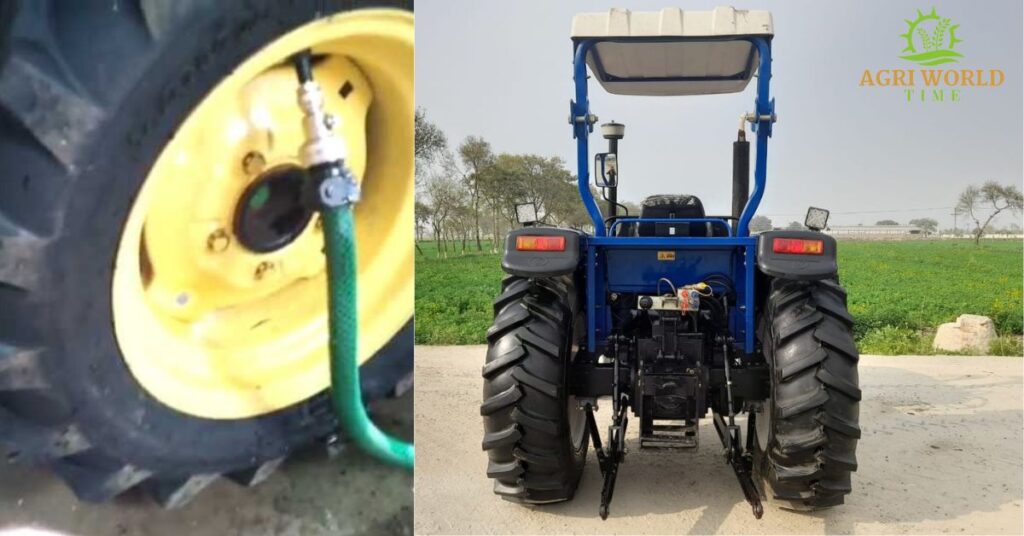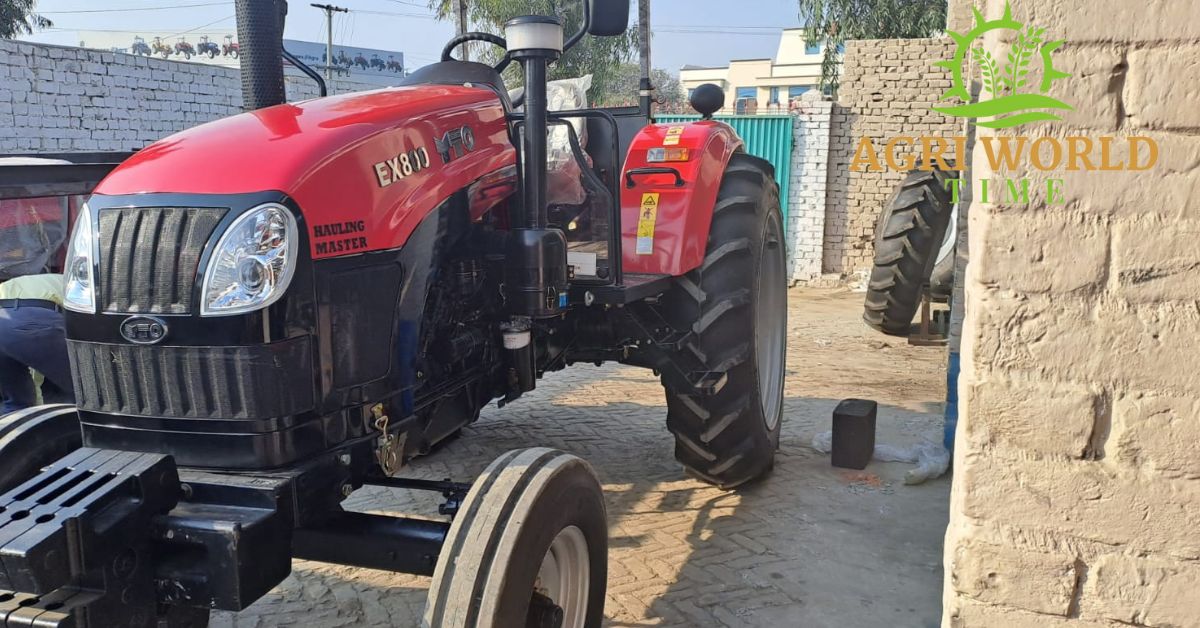Tractor tires are an essential component of any farm machinery. Their performance plays a vital role in the efficiency of farming operations. One way to improve the performance of tractor tires is by filling them with water. Water-filled tractor tires provide additional weight, which enhances traction, and stability, and prevents slippage. In addition, filling tires with water can also help reduce vibration. It reduces wear and tear on the tire and the machine. If you’re new to this process, you might be wondering how to fill tractor tires with water. In this blog post, we will guide you through the process and provide some tips to ensure that your tires are filled correctly and safely.
How to fill tractor tires with water?
Filling tractor tires with water is a straightforward process. It can be done by anyone with the right tools and materials. Here is a step-by-step guide to help you through the process:
Prepare the tires:
Before filling your tractor tires with water, ensure that they are clean and dry. Remove any debris or dirt that may have accumulated inside the tires.
Choose the right valve stem:
To fill your tractor tires with water, you’ll need to remove the valve stem core. Make sure to use a valve stem that is compatible with water, as some valve stems are designed only for air.
Choose the right water source:
You’ll need a clean and reliable water source to fill your tractor tires. Make sure the water is free of debris and contaminants.
Fill the tire:
Insert the hose into the valve stem and turn on the water. Let the water flow until the tire is full. You can use a pressure gauge to ensure that the tire is filled to the right pressure. Typically, you will want to fill your tire to 75-90% of its capacity with water.
Replace the valve stem core:
Once the tire is filled with water, replace the valve stem core. Use a valve stem cap to prevent any leakage.
Balance the tires:
Filling tires with water can sometimes cause them to become unbalanced. If this happens, you can balance the tire by adding or removing water as needed.
Check for leaks:
After filling the tire with water, inspect it for any leaks. Look for any signs of water seeping out of the tire or valve stem. If you notice any leaks, try tightening the valve stem or contact a professional for help.

What are the advantages of filling tractor tires with water?
Filling tractor tires with water can provide several advantages. Here are some of the benefits:
Increased traction:
Water-filled tires add weight to the tractor, which improves traction. This is especially beneficial when working in challenging terrains such as muddy fields or uneven surfaces. The increased grip allows the tires to maintain better contact with the ground. It reduces slippage and improves overall performance.
Improved stability:
Water-filled tires lower the tractor’s center of gravity, providing increased stability. This can be particularly useful when operating on slopes or working with heavy loads, as it reduces the risk of tipping over or losing control.
Smoother ride:
Water acts as a damping agent, absorbing vibrations and shocks. When tires are filled with water, they can provide a more comfortable ride by reducing the impact of bumps and uneven surfaces. This can be beneficial for both the operator’s comfort and to prevent damage to the tractor or its components.
Cost-effective solution:
Compared to alternative tire ballasting methods, such as using calcium chloride or Polyurethane foam, filling tractor tires with water is a more cost-effective option. Water is readily available and inexpensive. It makes it a convenient choice for farmers and tractor operators.
Easy adjustment:
The amount of water filled in the tires can be adjusted according to the specific needs of the job. If additional weight is required for better traction, more water can be added. Conversely, if less weight is desired, water can be drained from the tires. This flexibility allows for easy customization depending on the task at hand.
Reduced soil compaction:
Water-filled tires distribute the weight of the tractor over a larger surface area, resulting in reduced soil compaction. This is particularly important for farmers who want to minimize soil damage and preserve the fertility of their land.
What are the disadvantages of filling tractor tires with water?
While there are advantages to filling tractor tires with water, there are also some potential disadvantages to consider:
Freezing in cold temperatures:
Water-filled tires can freeze in cold weather conditions. When water freezes, it expands, which can lead to tire damage or even tire failure. This is particularly relevant in regions with severe winters. To prevent freezing, it is necessary to add an antifreeze solution to the water or consider alternative tire ballasting methods.
Increased tire wear:
Water-filled tires can cause increased wear and tear on the tires themselves. The additional weight of the water puts extra stress on the tire sidewalls and treads. It potentially leads to faster degradation and shorter tire lifespan. Regular tire inspections and maintenance are essential to monitor and address any signs of wear.
Difficult transportation:
Water-filled tires can be significantly heavier than air-filled tires, making them more challenging to transport. This can pose logistical difficulties, especially if the tractor needs to be transported over longer distances or on trailers. It’s important to consider the weight limitations of your trailer or transportation equipment when using water-filled tires.
Risk of leakage:
Over time, water-filled tires can develop leaks or punctures, leading to water loss. This not only reduces the effectiveness of the added weight but also requires repairs or tire replacement. Regular inspections and prompt repairs are necessary to address any leaks and prevent water loss.
Limited adjustability:
While the adjustability of water-filled tires is generally considered an advantage, it can also be a drawback in certain situations. Draining or adding water to adjust the tire weight requires additional time and effort compared to other ballasting methods. If frequent adjustments are needed, it can be more inconvenient than using alternative methods that allow for easier weight changes.
Corrosion risk:
Water contains minerals and impurities that can promote corrosion of the rim and other metal components within the tire. Corrosion can lead to damage, reduced tire performance, and potential safety hazards. Regular cleaning and maintenance are necessary to mitigate the risk of corrosion.
It’s important to carefully consider these disadvantages. Evaluate whether filling tractor tires with water is the most suitable option for your specific needs and operating conditions.
What are the alternatives to water for filling tractor tires?
While water is a popular choice for filling tractor tires, there are other alternatives that you may consider. Here are some alternatives to water for filling tractor tires:
Calcium chloride:
Calcium chloride is a chemical compound that’s commonly used as an alternative to water for filling tractor tires. It’s heavier than water, so it can increase the weight of the tire and provide better traction. It also has a lower freezing point than water, so it’s less likely to freeze in cold temperatures.
Polyurethane foam:
Polyurethane foam is a liquid foam that’s injected into the tire and hardens to provide support and stability. It’s a good option for tires that are used in rough terrain or heavy-duty applications.
Beet juice:
Beet juice is another alternative to water for filling tractor tires. It’s a natural substance that’s biodegradable and won’t harm the environment. It also has a lower freezing point than water, so it’s less likely to freeze in cold temperatures.
Nitrogen gas:
Nitrogen gas is another alternative to water for filling tractor tires. It’s a dry gas that won’t corrode the inside of the tire or cause rust. It also maintains tire pressure better than air or water.
When choosing an alternative to water for filling your tractor tires, consider your specific needs and requirements. Some alternatives may be more expensive or difficult to find than others, so it’s important to do your research and choose the option that’s best for you.
Conclusion:
Filling tractor tires with water is a cost-effective way to add weight and increase traction, especially in muddy or hilly terrain. By following the step-by-step guide and tips for proper filling and maintenance, you can ensure that your tractor tires perform optimally and have a long lifespan. Additionally, knowing about the alternatives to water for filling tractor tires can help you make an informed decision about what option is best for your specific needs and requirements. Understanding the importance of traction force can also help you appreciate the critical role that it plays in the movement and performance of objects and machines. By keeping these factors in mind, you can make the most of your tractor and ensure its efficient and effective operation.
FAQS
Can I use regular tap water to fill my tractor tires?
Yes, you can use regular tap water to fill your tractor tires. However, using distilled water is recommended to avoid minerals and contaminants that can cause corrosion.
How often should I check the tire pressure of my water-filled tractor tires?
You should check the tire pressure of your water-filled tractor tires at least once a month or before each use to ensure that they’re properly inflated.
How do I know if my water-filled tractor tire has a leak?
You can check for leaks by looking for any visible punctures or cracks in the tire. You can also listen for any hissing sounds or use a soapy water solution to identify any leaks.
Can I drain and refill my water-filled tractor tire myself?
Yes, you can drain and refill your water-filled tractor tire yourself. However, it’s important to take safety precautions, such as wearing gloves and eye protection, and following the proper procedure to avoid injury or damage to the tire.
What is traction force?
Traction force refers to the force that enables an object or vehicle to grip or maintain contact with a surface. It prevents slippage or loss of control.
Why is traction force important?
Traction force is crucial for various applications, such as tractor movement, machine operation, and sports performance. It allows for efficient propulsion, stability, and control.

